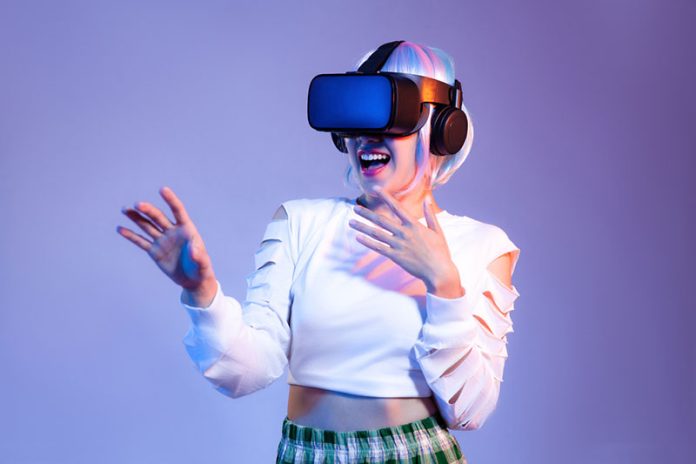By Adina-Laura Achim
During the pandemic, luxury and premium brands were forced to scrap fashion shows and in-person events from their calendars and come up with innovative ways to connect with their audiences. As such, the jam-packed fashion calendar moved online and “phygital” became the new thing. But despite the plethora of digital channels developed and extended during the pandemic, the move seemed transitory.
Let’s face it, watching the likes of Karlie Kloss and Alessandra Ambrosio showcasing designer garments from the comfort of their homes seemed more like Big Brother or a social experiment than anything remotely glamorous or high- fashion. But despite the clumsiness and oddness of digital catwalks, the phenomenon has pushed the limits of the fashion world, helping designers and premium labels innovate and take digital transformation more seriously.
In this context, NFTs, avatars, live-streaming, and elements of gamification took the retail world by storm. However, many wondered if this is just the latest hype or the future of fashion.
The Metaverse Fashion Week (MVFW22) hosted by Decentraland, shows that premium brands are ready to embrace the virtual lifestyle. Some well-known labels like DKNY, Tommy Hilfiger, Paco Rabanne, Etro, and Dolce & Gabbana, among others, took part in the event, but heritage companies were notably absent. Meanwhile, the digital after-parties, expert talks, and 3D catwalks didn’t attract a large crowd. In fact, various publications, including Vogue and Mashable, noted that the events were poorly attended. Not only that but, the graphics didn’t create immersive experiences and the interactions seem fake, so it is highly doubtful that too many adults would feel the need to “interact” with virtual worlds. To make matters worse, technical glitches and challenges were also downgrading the experience.
“The final experience was far from seamless — technical difficulties, overheating hard drives and lack-luster graphics dimmed the fantasy of this supposedly limitless landscape,” said CNN.
Without a doubt, these problems are prevalent when dealing with digital technologies, but Decentraland and the fashion brands taking part in the events should have found feasible solutions before inviting guests to the MVFW22. By overlooking and downplaying challenges, these companies have damaged their own reputation and created additional risks that could impact their image and hurt their revenues.
Timothy J. Druzbik, Walmart Senior- Manager, Strategy and Business Development told The World Financial Review that the Metaverse is still evolving.
“While brands actively navigate this virtual world in hopes, it will provide a more intimate customer experience, as a sales channel it currently represents a very small percentage of total retail e-commerce GMV,” said Druzbik. “The Metaverse can certainly redefine what is possible across the digital marketing realm and reshape the consumer purchase decision journey; but perhaps it has not yet proven to be a go-to channel.”
Andrew Tran, principal marketing strategist, AT Digital told The World Financial Review that there are several risks associated with the Metaverse. And although “the effort to reward ratio might be low,” Tran believes brands should play the “long game.”
“Fashion week Metaverse style will be a new dimension for brands to seek attention, presence and legitimacy in the eyes of the consumer,” said Tran. “How people will adopt this over time will depend on the early investment by brands to normalise this channel now and over the years ahead.”
Even though the Metaverse is facing challenges, there are selective possibilities ahead. In fact, premium fashion labels can use the gawky experience to innovate and create relevant and richer digital interactions. An immersive ecosystem like the Metaverse offers tremendous opportunities for traditional brands to bridge the gap between digital and physical, and become even more consumer-centric.
According to Druzbik, the Metaverse “provides a medium for brands and consumers to meet and engage, anywhere at any time.”
Druzbik continued: “As fashion houses have doubled down and experimented on their DTC e-commerce channels through livestreaming, mixed reality, and virtual avatar idols – this entrance into the Metaverse, pushes the limits on retail innovation, and creatively connects with key consumers.”
Looking at current initiatives, it is evident that fashion companies understand the potential of the Metaverse, but several businesses have jumped too early on the bandwagon without properly understanding the technologies behind the virtual world or having a clear strategy in place.
Moving forward, the fashion world should work towards securing skilled talent instead of partnering with third-parties and putting their digital transformation strategy in their hands. Also, fashion businesses should develop new data strategies that mitigate the risks of privacy violations and data breaches. This is especially important considering that Meta wants to collect and utilize biometric information in order to create hyper-realistic avatars and improve VR interactions. Last, fashion companies should design well-functioning “phydigital” experiences similar to the in-store AR displays used by Zara instead of betting big on the Metaverse. Shoppers still have limited familiarity with the Metaverse and their desire to interact with the virtual world is low. According to research from Zappi, 55 percent of respondents across the US and the UK say they don’t understand the Metaverse.
































































